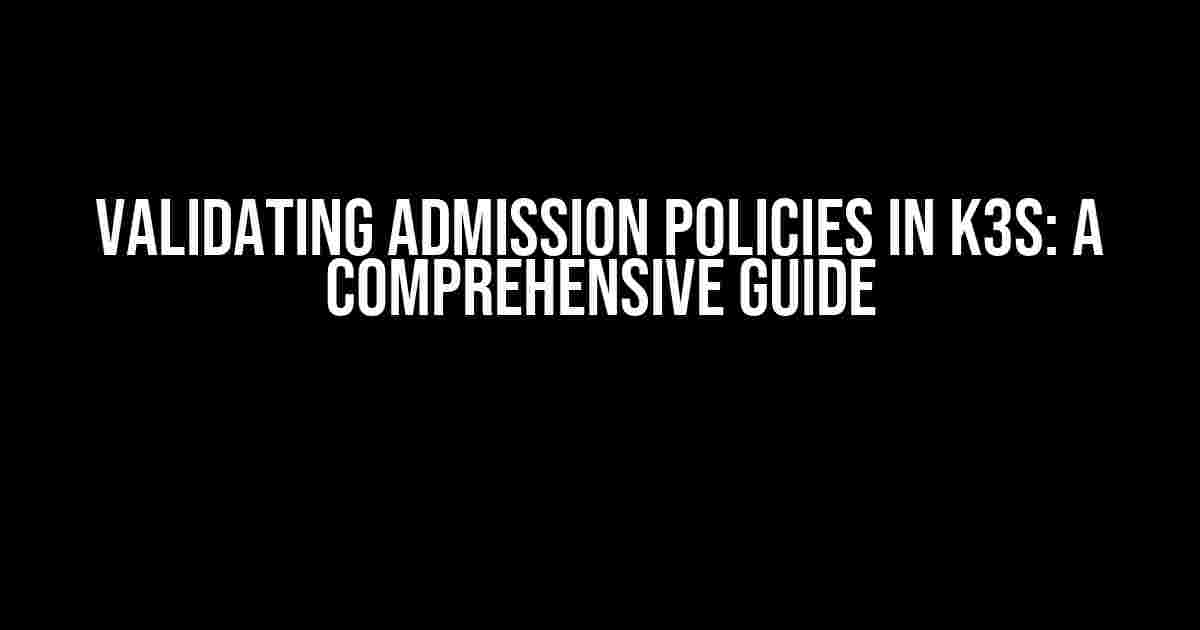As a Kubernetes administrator, ensuring the security and integrity of your cluster is of paramount importance. One crucial aspect of cluster security is admission control, which involves validating and mutating requests to create or update resources within the cluster. In this article, we’ll dive into the world of ValidatingAdmissionPolicies in K3s, a lightweight, certified Kubernetes distribution.
What are ValidatingAdmissionPolicies?
A ValidatingAdmissionPolicy is a type of admission control policy that verifies whether a request meets certain criteria before allowing it to proceed. These policies are essential for maintaining cluster security, as they prevent unauthorized or malformed requests from being processed.
In K3s, ValidatingAdmissionPolicies are implemented using admission webhooks, which are HTTP callbacks that receive admission requests and return a response indicating whether the request is valid or not.
Why Use ValidatingAdmissionPolicies?
ValidatingAdmissionPolicies offer several benefits, including:
- Improved Cluster Security: By validating requests, you can prevent unauthorized access, data breaches, and other security threats.
- Enhanced Compliance: ValidatingAdmissionPolicies can help you meet regulatory requirements and industry standards, such as HIPAA, PCI-DSS, and GDPR.
- Increased Efficiency: By automating validation, you can reduce the workload on your cluster administrators and improve overall cluster performance.
Creating a ValidatingAdmissionPolicy in K3s
To create a ValidatingAdmissionPolicy in K3s, you’ll need to create a `ValidatingWebhookConfiguration` resource and a corresponding admission webhook server. Here’s a step-by-step guide to get you started:
Step 1: Create an Admission Webhook Server
First, you’ll need to create an admission webhook server that will receive and process admission requests. You can use any programming language and framework to create the server, but for simplicity, we’ll use a Go-based example.
package main
import (
"encoding/json"
"fmt"
"net/http"
)
type AdmissionReview struct {
TypeMeta struct {
Kind string `json:"kind"`
} `json:"metadata"`
Request struct {
UUID string `json:"uid"`
Object metav1.Object `json:"object"`
} `json:"request"`
Result metav1.Status `json:"result"`
}
func main() {
http.HandleFunc("/validate", func(w http.ResponseWriter, r *http.Request) {
var admissionReview AdmissionReview
err := json.NewDecoder(r.Body).Decode(&admissionReview)
if err != nil {
http.Error(w, err.Error(), http.StatusBadRequest)
return
}
// Perform validation logic here
admissionReview.Result.Message = "Validation successful"
admissionReview.Result.Status = metav1.Status{
Code: int32(http.StatusOK),
}
json.NewEncoder(w).Encode(&admissionReview)
})
fmt.Println("Admission webhook server listening on port 8080")
http.ListenAndServe(":8080", nil)
}
Step 2: Create a ValidatingWebhookConfiguration Resource
Once you have your admission webhook server up and running, create a `ValidatingWebhookConfiguration` resource to register the webhook with K3s.
apiVersion: admissionregistration.k8s.io/v1
kind: ValidatingWebhookConfiguration
metadata:
name: my-webhook
webhooks:
- name: my-webhook.default.svc
clientConfig:
url: "https://my-webhook.default.svc:8080/validate"
caBundle: ""
rules:
- apiGroups:
- ""
apiVersions:
- v1
operations:
- CREATE
resources:
- pods
Step 3: Apply the ValidatingWebhookConfiguration Resource
Apply the `ValidatingWebhookConfiguration` resource to your K3s cluster using the following command:
kubectl apply -f validating-webhook-configuration.yaml
Validating Admission Requests
Now that you have your ValidatingAdmissionPolicy in place, let’s explore how to validate admission requests.
Request Validation Logic
In the admission webhook server code, you can implement custom validation logic to verify admission requests. For example, you might want to check if a pod has a specific label or annotation:
if admissionReview.Request.Object.(metav1.ObjectMeta).Labels["app"] != "my-app" {
admissionReview.Result.Message = "Pod must have label app=my-app"
admissionReview.Result.Status = metav1.Status{
Code: int32(http.StatusForbidden),
}
return
}
Returning Admission Review Responses
After validating the admission request, return an `AdmissionReview` response to K3s, indicating whether the request is valid or not.
admissionReview.Result.Message = "Validation successful"
admissionReview.Result.Status = metav1.Status{
Code: int32(http.StatusOK),
}
json.NewEncoder(w).Encode(&admissionReview)
Troubleshooting ValidatingAdmissionPolicies
When working with ValidatingAdmissionPolicies, you might encounter some common issues. Here are some troubleshooting tips to help you debug:
| Error | Solution |
|---|---|
| Admission webhook server not reachable | Verify that the admission webhook server is running and listening on the correct port. Check the server logs for errors. |
| Invalid admission request | Check the admission request payload to ensure it conforms to the expected format. Verify that the request is correctly encoded in JSON. |
| Validation logic errors | Review the validation logic in your admission webhook server code to ensure it is correct and functioning as expected. |
Conclusion
In this article, we’ve explored the world of ValidatingAdmissionPolicies in K3s, a powerful tool for securing your Kubernetes cluster. By creating a custom admission webhook server and registering it with K3s, you can validate admission requests and ensure the integrity of your cluster.
Remember to carefully design and implement your validation logic to meet your specific security requirements. With ValidatingAdmissionPolicies, you can rest assured that your cluster is protected from unauthorized access and malicious requests.
Further Reading
If you’re interested in learning more about admission control in Kubernetes, check out the official documentation on admission controllers.
For more information on K3s, visit the official K3s website.
Frequently Asked Questions
Got questions about validating admission policies in K3s? We’ve got answers!
What is the primary goal of validating admission policies in K3s?
The primary goal of validating admission policies in K3s is to ensure that only authorized and validated requests can access cluster resources, thereby preventing unauthorized access and potential security breaches.
How does K3s validate admission policies?
K3s validates admission policies through a combination of admission controllers, which are plugins that intercept and modify requests to the API server. These controllers evaluate the admission policies and either admit or deny requests based on the defined rules.
What types of admission policies can be validated in K3s?
K3s supports a wide range of admission policies, including Network Policies, Resource Quotas, Pod Disruption Budgets, and more. These policies can be used to control and restrict access to cluster resources, ensuring a more secure and compliant environment.
Can I customize admission policies in K3s?
Yes, K3s allows you to customize admission policies to fit your specific use case and security requirements. You can create custom admission webhooks and plugins to enforce your own admission policies, or modify existing ones to suit your needs.
How often should I validate admission policies in K3s?
It’s essential to regularly validate admission policies in K3s to ensure they are up-to-date and effective. You should validate policies whenever you make changes to your cluster configuration, add new resources, or update existing ones.
